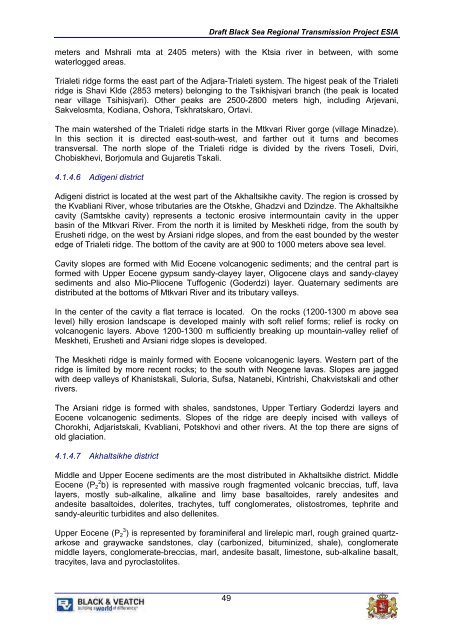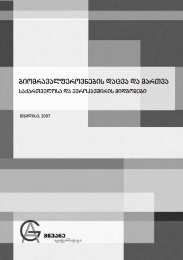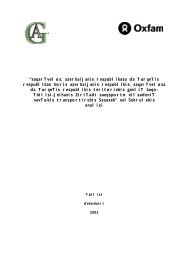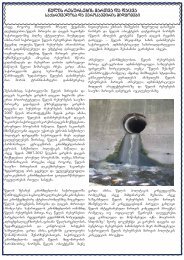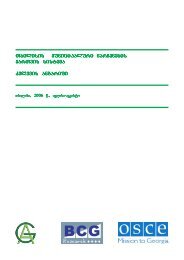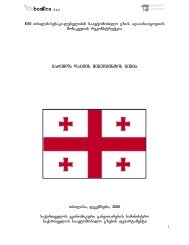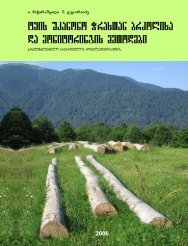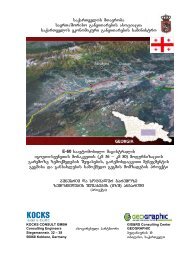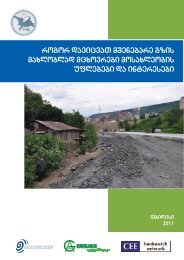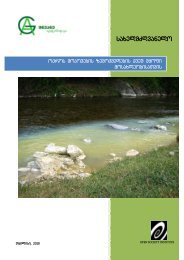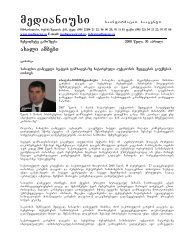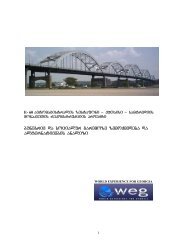Part I
Part I
Part I
You also want an ePaper? Increase the reach of your titles
YUMPU automatically turns print PDFs into web optimized ePapers that Google loves.
Draft Black Sea Regional Transmission Project ESIA<br />
meters and Mshrali mta at 2405 meters) with the Ktsia river in between, with some<br />
waterlogged areas.<br />
Trialeti ridge forms the east part of the Adjara-Trialeti system. The higest peak of the Trialeti<br />
ridge is Shavi Klde (2853 meters) belonging to the Tsikhisjvari branch (the peak is located<br />
near village Tsihisjvari). Other peaks are 2500-2800 meters high, including Arjevani,<br />
Sakvelosmta, Kodiana, Oshora, Tskhratskaro, Ortavi.<br />
The main watershed of the Trialeti ridge starts in the Mtkvari River gorge (village Minadze).<br />
In this section it is directed east-south-west, and farther out it turns and becomes<br />
transversal. The north slope of the Trialeti ridge is divided by the rivers Toseli, Dviri,<br />
Chobiskhevi, Borjomula and Gujaretis Tskali.<br />
4.1.4.6 Adigeni district<br />
Adigeni district is located at the west part of the Akhaltsikhe cavity. The region is crossed by<br />
the Kvabliani River, whose tributaries are the Otskhe, Ghadzvi and Dzindze. The Akhaltsikhe<br />
cavity (Samtskhe cavity) represents a tectonic erosive intermountain cavity in the upper<br />
basin of the Mtkvari River. From the north it is limited by Meskheti ridge, from the south by<br />
Erusheti ridge, on the west by Arsiani ridge slopes, and from the east bounded by the wester<br />
edge of Trialeti ridge. The bottom of the cavity are at 900 to 1000 meters above sea level.<br />
Cavity slopes are formed with Mid Eocene volcanogenic sediments; and the central part is<br />
formed with Upper Eocene gypsum sandy-clayey layer, Oligocene clays and sandy-clayey<br />
sediments and also Mio-Pliocene Tuffogenic (Goderdzi) layer. Quaternary sediments are<br />
distributed at the bottoms of Mtkvari River and its tributary valleys.<br />
In the center of the cavity a flat terrace is located. On the rocks (1200-1300 m above sea<br />
level) hilly erosion landscape is developed mainly with soft relief forms; relief is rocky on<br />
volcanogenic layers. Above 1200-1300 m sufficiently breaking up mountain-valley relief of<br />
Meskheti, Erusheti and Arsiani ridge slopes is developed.<br />
The Meskheti ridge is mainly formed with Eocene volcanogenic layers. Western part of the<br />
ridge is limited by more recent rocks; to the south with Neogene lavas. Slopes are jagged<br />
with deep valleys of Khanistskali, Suloria, Sufsa, Natanebi, Kintrishi, Chakvistskali and other<br />
rivers.<br />
The Arsiani ridge is formed with shales, sandstones, Upper Tertiary Goderdzi layers and<br />
Eocene volcanogenic sediments. Slopes of the ridge are deeply incised with valleys of<br />
Chorokhi, Adjaristskali, Kvabliani, Potskhovi and other rivers. At the top there are signs of<br />
old glaciation.<br />
4.1.4.7 Akhaltsikhe district<br />
Middle and Upper Eocene sediments are the most distributed in Akhaltsikhe district. Middle<br />
Eocene (P 2 2 b) is represented with massive rough fragmented volcanic breccias, tuff, lava<br />
layers, mostly sub-alkaline, alkaline and limy base basaltoides, rarely andesites and<br />
andesite basaltoides, dolerites, trachytes, tuff conglomerates, olistostromes, tephrite and<br />
sandy-aleuritic turbidites and also dellenites.<br />
Upper Eocene (P 2 3 ) is represented by foraminiferal and lirelepic marl, rough grained quartzarkose<br />
and graywacke sandstones, clay (carbonized, bituminized, shale), conglomerate<br />
middle layers, conglomerate-breccias, marl, andesite basalt, limestone, sub-alkaline basalt,<br />
tracyites, lava and pyroclastolites.<br />
49


